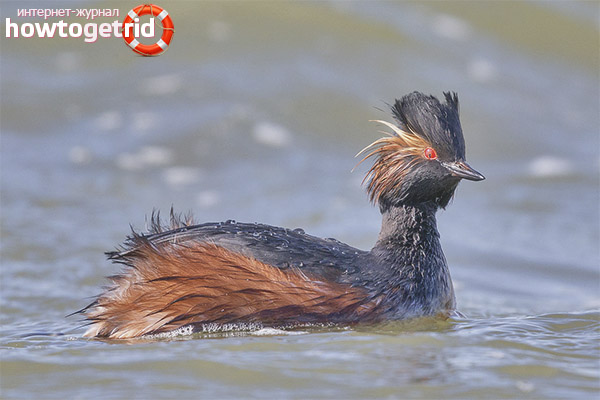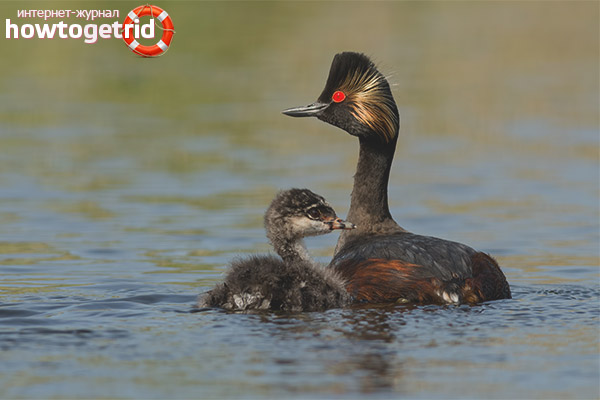The content of the article
The Black-necked Grebe is also called the Grebe duck due to its specific coloration. According to its characteristics, the represented waterfowl is not too noticeable for ordinary people. But connoisseurs know that there are many characteristics that distinguish the toadstool from all other relatives. We immediately specify that there are no differences in gender in terms of color. Today we will study everything that affects black-necked birds.
Habitat
Feathered friends of the presented species are quite common. But they prefer to nest in certain climatic zones and regions. We are talking about New Zealand, Asia, Australia, Africa, Europe.
Settlement is carried out only in hot climatic regions. For wintering, they are transported to warm regions, usually these are Asia and Europe (southern parts). If in the habitat of the grebes water sources become covered with a crust of ice, the birds prepare for migration to hot places.
Nest exclusively in stagnant bodies of water or where the current is too slow. The duck will nest only in places of accumulation of dense vegetation along the outskirts of the water.
Description
In terms of size, these waterfowl are small-sized. Females reach a mass of 0.4 kg., Males - 0.45 kg. The size of the beak is an average of 20-25 cm, and the length of the wings is from 119 to 144 cm.
- By color, males and females are similar during the mating season. They have feathers of golden tint from the lateral parts of the head behind the eye area. The occipital region is endowed with a crest. The rest of the bird is black (head, neck, dorsal and thoracic parts). On the lower section of the chest there are brown marks. On the sides of the red, the abdomen is white. The area under the wings is white, under the tail - gray, like haze. The beak is grayish, charcoal. Paws are black on the outside, and olive on the inside with a gray undertone. The iris is reddish, but significantly lighter, approaching the pupil.
- The after-breeding outfit of birds is also identical. The neck, cervical anterior, and the chest area are whitish. A redhead remains behind the eye area.
- Winter outfit of birds has some differences. For example, there is no crest on the back of the head. There are no golden patches in the plumage area. By their color, the birds become much lighter, light marks are noticed behind the head. The neck on the sides and front, as well as the neck, abdomen and chest are white. On the back, back of the neck and behind the head, the feathers are covered in a black (dark gray) tone.
- The chick that appeared at the grebe duck also needs a description. It has a plain black back, a light abdominal part. On the head there is a pair of light mottled. The upper neck and neck area boasts black markings. The cannon is short but thick. The beak is colored reddish with several black stripes. The iris is brownish.
Lifestyle
- On land, members of the family are uncomfortable. Due to short paws, the bird literally crawls on the ground, slowly moving. However, in the body of water, fish literally come to life, as they are excellent swimmers and dives.
- Ducks use only their paws when diving, which allow them to move quickly without much effort. If danger looms, the bird immediately dives deeper, clutching its wings for better streamlining.
- In ordinary life, these birds practically do not fly. They use their wings only during the migration to winter. Most of the existence is in the water. On the shore, the represented family is chosen to brush feathers or keep warm.
- To the enemies of grebes can be attributed birds of prey, for example, a crow or a swamp moon. Predators feed on duck eggs, killing the nest. Also, small chicks after birth are in danger, because they can be eaten by large predatory fish.
- For a long time, grebe-ducks were hunted because of rich feathers. The fashion for jewelry has passed, and the number for this period has significantly decreased.
Food
- It is worth knowing that adults spend almost all the time in water. Such a habitat is considered the most convenient for them. Thus, the nutrition of birds from this has changed a lot. Often individuals feed on small fish, sometimes medium. In addition, the duck can eat aquatic insects, frogs, aquatic plants and crustaceans.
- To get to food, such birds are often forced to dive into the input. Individuals can be without air for up to 20 seconds. However, it is worth noting that such birds often die, becoming entangled at depth in fishing nets. Individuals were even found at a depth of more than 30 m. This is due to the fact that in winter ducks have to dive deeper for food.
Mating season
- Large representatives of this family have a rather amazing and unusual mating season, which is interesting to watch. At this time, individuals can see bundles of dark feathers on the back of the head. From far away they look like horns. Ducks also have whiskers in the lower part of the head.
- During the mating ritual, birds begin to dance with each other, while spreading their wings wide. Also, individuals stretch their neck strongly, while in their beak they have a bunch of algae. Also during the mating season, such ducks make quite loud noises. They can be heard from afar.
- After the adults are divided into pairs, they begin to equip the nest. It looks rather unusual. Poultry housing is built on a floating islet of peat or in a pile of dried grass. As a building material, birds use reed stalks and all kinds of leaves.
Grebe ducks have a beautiful appearance. They are quite unusual individuals, which are interesting to watch. If you can catch the mating season, you will remember the dances for a long time. During this period, birds acquire incredible beauty. Among other things, it is very interesting to observe the construction of the nest.
Video: Black-necked Grebe (Podiceps nigricollis)












Submit